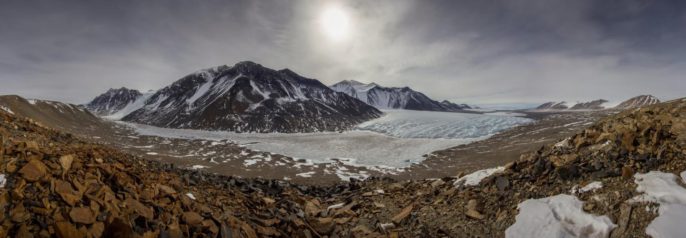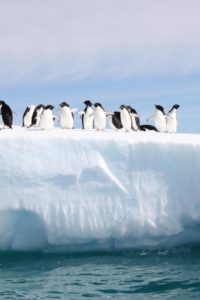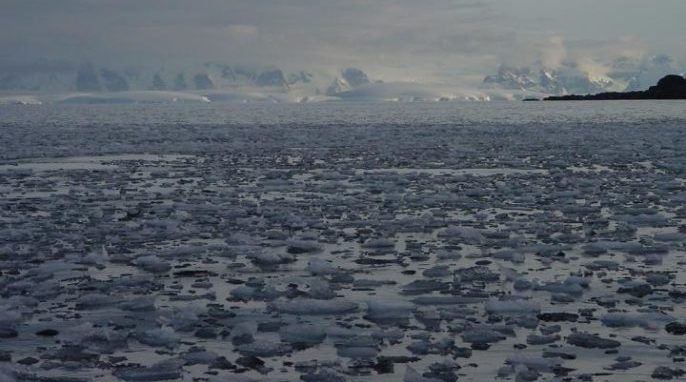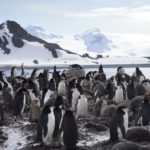What Happens When Antarctica Melts?
By Kate Stone
Between December 2001 and February 2002, the Antarctic continent underwent a season of intense melting. Aside from the loss of ice, what really happens when Antarctica melts? New research reveals that the changes range from sped-up microbial food webs to shifting penguin populations.
The clash of two climatic cycles, the Southern Annular Mode and the El Niño Southern Oscillation, produced an unusually warm and windy spring season across Antarctica back in 2001–2002. This climate event melted glaciers including the Totten Glacier, thinned lake ice, and caused startling changes to the Antarctic sea ice. Fortunately, researchers were on hand to observe and document the event, giving us a glimpse into the ecological future of this most remote continent as Antarctica melts away.
Tweet about it: What is the ecological future of the most remote continent, as Antarctica melts away?
The Palmer LTER (Long Term Ecological Research) study area, located at the National Science Foundation’s Palmer Station since 1990, is where scientists go to study the ways that changing sea ice affects marine ecology. The McMurdo Dry Valleys LTER, established in 1992, explores the ecology of the terrestrial and freshwater ecosystems of Antarctica’s Dry Valleys. The Dry Valleys are an ice-free polar desert. One researcher captured amazing images of the McMurdo Dry Valleys using time-lapse photography.


“These two vastly different polar ecosystems offer insights into how diverse ecosystems around the world will respond to climate change,” says Hugh Ducklow, the Columbia University ecologist who leads the Palmer LTER. “With long-term studies already in place, we were able to observe the effects on so many different levels.” One of those studies recently measured the carbon released into our atmosphere during the last deglaciation period.
Sea Ice Changes Ricochet up the Food Web
Climate conditions caused the sea ice to thicken in part of the West Antarctic Peninsula in 2001–2002. At the same time, melting increased at the edge, releasing large quantities of fresh water and ice-bound algae directly into the ocean. These added nutrients fueled a large spring population of algae and Antarctic krill, a major food source for penguins, whales, seals, fish, and flighted seabirds.


Animals living along the peninsula coast were also treated to greater snowfall and earlier spring snowmelt. The nests of early-hatching Adélie penguins were wiped out by resultant flooding, and the advantage went to later-nesting gentoo and chinstrap penguins.
Antarctica Melts, Wets the Dry Valleys
Further south in the Dry Valleys, wind rapidly melted the mountain glaciers, releasing water across the dry landscape, scouring streambeds, raising lake levels, and releasing windblown dust deposits long buried inside the glacial ice. The lake ice suddenly thinned from its usual six meters, allowing more sunlight than usual to reach the upper layers of the plankton community that thrives in lake water under the ice.
Today’s Anomaly, Tomorrow’s Normality
The observable impacts of the 2001–2002 climate anomaly came and went. However, that single season of warming was the start of nearly a decade of rising lake levels and Antarctic habitat change.
In so many ways, ice protects Antarctica from environmental change, but only to a certain extent. Long-term ecological research is allowing scientists to understand how ecosystems may respond when unusual weather becomes the typical climate.
These findings were published in BioScience, the journal of the American Institute of Biological Sciences (AIBS).
Featured image: An unusual intersection of climate patterns intensified sea ice and glacier melt in the spring of 2001–2002. Credit: Hassan Basagic/McMurdo LTER via CC by-SA 4.0.
References
Unravelling Ecosystem Responses to Climate Change on the Antarctic Continent Through Long Term Ecological Research by John C. Priscu. doi:10.1093/biosci/biw131
The Impact of a Large-scale Climate Event on Antarctic Ecosystem Processes by Andrew G. Fountain, Grace Saba, Byron Adams, Peter Doran, William Fraser, Michael Gooseff, Maciek Obryk, John C. Priscu, Sharon Stammerjohn, Ross A. Virginia. doi:10.1093/biosci/biw110
Responses of Antarctic Marine and Freshwater Ecosystems to Changing Ice Conditions by Maciej K. Obryk, Peter T. Doran, Ari S. Friedlaender, Michael Gooseff, Wei Li, Rachael Morgan-Kiss, John C. Priscu, Oscar Schofield, Sharon E. Stammerjohn, Deborah K. Steinberg, and Hugh W. Ducklow. doi:10.1093/biosci/biw109
Microbial Community Dynamics in Two Polar Extremes: The Lakes of the McMurdo Dry Valleys and the West Antarctic Peninsula Marine Ecosystem by Jeff S. Bowman, Trista J. Vick-Majors, Rachael Morgan-Kiss, Cristina Takacs-Vesbach, Hugh W. Ducklow, and John C. Priscu. doi:10.1093/biosci/biw103




